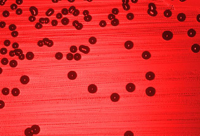Hib-meningitis vaccine
 Meningitis means swelling of the meninges, membranes covering the brain and spinal cord. It is caused by infection with one of several types of bacteria or virus, the bacterial forms being most serious. In the UK outbreak in 1995 about 200 people died, most of these deaths caused by the meningococcal B strain. There is currently no vaccine to protect against this strain.
Meningitis means swelling of the meninges, membranes covering the brain and spinal cord. It is caused by infection with one of several types of bacteria or virus, the bacterial forms being most serious. In the UK outbreak in 1995 about 200 people died, most of these deaths caused by the meningococcal B strain. There is currently no vaccine to protect against this strain.
A Vaccine for hib-meningitis
Animal studies further vaccine development
Worldwide vaccination
References
A Vaccine for hib meningitis
Haemophilus influenzae type B (Hib) is another bacterial form of meningitis. It was first described by Richard Pfeiffer in 1892 during an influenza outbreak, and was mistakenly thought to be the cause of 'flu until 1933, when it became clear that 'flu was caused by a virus. In October 1992, vaccination against infection by the Hib bacterium, then a major cause of meningitis in young children, was included in the childhood immunisation programme in Britain. The effect was immediate, for Hib infections fell by 70% from January to March in 1993.ANCHOR
The introduction of the vaccine in Britain was triggered by its outstanding success in Finland, where Hib meningitis had been steadily rising since the 1960s. The introduction of the vaccine in 1986 reduced the incidence of Hib meningitis to zero by 1991.ANCHOR Similar benefit had been reported in three studies of Hib meningitis in the USA, where the incidence fell by 80-90% over a two-year period following vaccination against Hib.ANCHOR
Prior to vaccination, 1,500 cases of Hib infection occurred every year in the UK (mostly in children under one year), over half resulting in meningitis. Despite the effectiveness of antibiotics against the bacillus, it killed 65 children and caused permanent brain damage, deafness etc in a further 150 each year. There was a considerable drive to prevent this potentially devastating disease, but research was difficult because of the way the bacteria interact with the immune system. The immune response is stimulated by a large sugar on the surface of the bacterium called PRP. Vaccines based on PRP could only produce a poor, short-lived immunity in children under one year, ie those at greatest risk.
Animal studies further vaccine development
After much experimentation a better vaccine based on PRP was produced by joining it to a protein. This type of technique had already been effective in protecting mice against bacteria that caused pneumonia.ANCHOR PRP joined to a protein was shown to produce a powerful immune response in mice and rabbits.ANCHOR From these experimental studies four effective vaccines were developed for human use. Each vaccine was of course subject to the standard animal tests for safety.
Worldwide vaccination
The hib-meningitis vaccination programme has been successful throughout the world, with incidence dramatically reduced in Bangladesh, Kenya and Chile. A recent study in Gambia also showed that the annual incidence of Hib meningitis declined from 60 to zero cases per 100 000 children aged under 5 years, during a five-year period after the introduction of the Hib vaccine.ANCHOR
Most recently, it has been reported that the incidence of hib-meningitis in Uganda has been reduced to zero in children under Five. It is thought that the deaths of around 5000 children a year have been prevented since the Ugandan vaccination programme began in 2001.ANCHOR
References
- Pharm J (1993) 250, 633
- Peltola H, Kilpi T, Anttila M (1992) Lancet 340, 592
- Dixon B (1993) Microbe of the Month. The Independent, February 8
- Sood S & Daum R (1991) in Vaccines and Immunotherapy ed Cryz S. Pergamon New York
- Sood S & Daum R (1991) in Vaccines and Immunotherapy ed Cryz S. Pergamon New York
- Adegbola R, Secka O, Lahai G et al. (2005) Lancet 366, 144
- WHO bulletin (2008) -published online ahead of print, Mar 10. doi: 10.1471/BLT.07.042580
Related links
Meningitis research foundation http://www.meningitis.org/
Last edited: 3 November 2014 17:24
